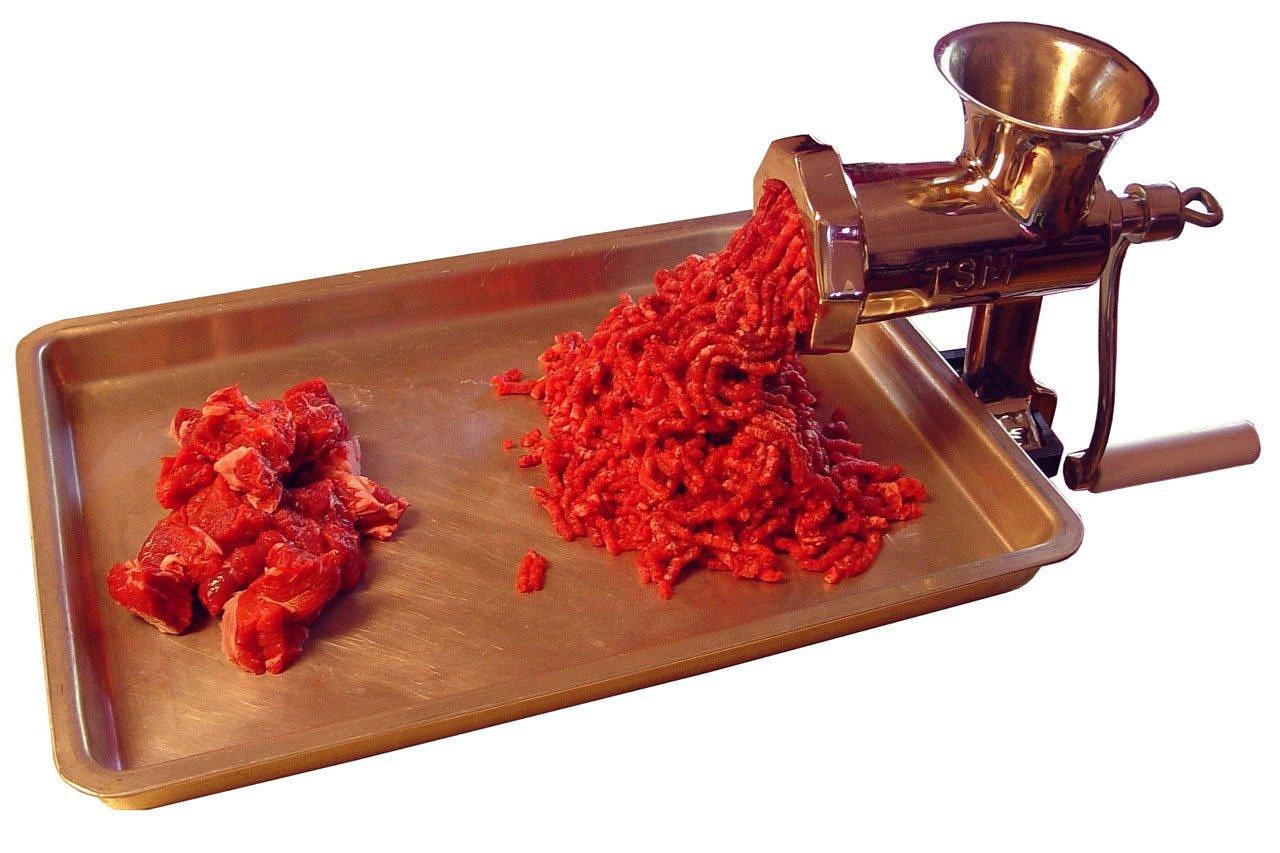Why Immediate Cleaning is Non-Negotiable for Meat Grinders
Cleaning a meat grinder immediately after use is the single most critical step in maintaining both the longevity of your equipment and, more importantly, the safety of your food. Raw meat residue, if left even for a short time, creates an ideal environment for rapid bacterial growth, including pathogens like E. coli and Salmonella. Furthermore, residual moisture combined with meat proteins can lead to corrosion, particularly in cast iron components, significantly shortening the lifespan of your machine.
This comprehensive guide provides a step-by-step protocol for cleaning, sanitizing, and properly storing all types of meat grinders, from manual hand-crank models to heavy-duty electric units.
Phase 1: Preparation and Initial Debris Removal
Before you begin the wet cleaning process, you must clear the grinding chamber of residual meat and fat. Attempting to wash the grinder while it still contains large pieces of debris will only smear fat and clog drains.
Step 1: Disassemble the Grinder
Unplug the electric grinder or secure the manual unit. Carefully disassemble all removable parts. This typically includes:
- The hopper (feed tray)
- The locking ring (collar)
- The grinding plate (die)
- The cutting knife (blade)
- The auger (worm)
- The grinder head (housing)
Lay all parts out on a clean surface. Consult your electric meat grinder buying guide or manual if you are unsure about specific components.
Step 2: Clear Residual Meat with Stale Bread or Rice
To push out the last traces of meat and fat, run a non-abrasive, absorbent material through the grinder while it is still assembled (or partially assembled):
- Use Stale Bread: Tear up 2-3 slices of stale bread (or frozen bread, which is firmer) and feed them through the grinder. The bread absorbs fat and pushes out meat fibers.
- Use Raw Rice (Optional): For very sticky residue, a handful of raw, uncooked rice can be fed through. The hard grains act as a gentle abrasive to scour the interior of the auger and plate.
Once the material coming out is clean, you can proceed to wet cleaning.
Phase 2: Deep Cleaning and Sanitization of Parts
This phase requires hot water and specialized cleaning tools to ensure every crevice is free of residue.
Step 3: Pre-Rinse with Cold Water
Crucial Step: Rinse all disassembled parts under cold running water first. Hot water will cook and set the proteins and fats onto the metal surfaces, making them much harder to remove. Use cold water to flush away loose debris.
Step 4: Washing with Hot, Soapy Water
Use a strong dish detergent that is effective at cutting grease. Fill a basin with hot water and detergent, and submerge all parts (except the motor housing of electric models).
- Use Specialized Brushes: A bottle brush or a small, stiff-bristled cleaning brush is essential for cleaning the interior of the grinder head and the threads of the auger. Use a toothpick or a dedicated plate cleaning tool to clear the small holes in the grinding plate. This process is key to cleaning meat grinder plate.
- Handle Knives Carefully: Wash the cutting knife and plates separately to avoid accidental cuts. Always wash them immediately to prevent rust spots from forming.
Step 5: Sanitization (The Food Safety Step)
Cleaning removes visible dirt; sanitizing kills microscopic bacteria. This step is mandatory for food safety.
- Vinegar Solution: For a natural approach, soak the parts for 15 minutes in a solution of one part white vinegar to four parts water. This helps neutralize odors and provides mild sanitization.
- Bleach Solution (Stronger): For maximum sanitation, use a solution of 1 tablespoon of unscented liquid chlorine bleach per gallon of cool water. Soak the parts for at least one minute, then rinse thoroughly with clean water.
Phase 3: Drying, Lubrication, and Storage
Improper drying is the leading cause of rust, especially when cleaning meat grinder parts.
Step 6: Thorough Drying
Do not allow parts to air dry, as this promotes rust formation, particularly on cast iron models.
- Towel Dry: Immediately dry every single component with a clean, lint-free towel.
- Air Dry (Supplemental): Place the components on a rack or baking sheet in a warm, dry area for 30–60 minutes to ensure all internal moisture evaporates.
Step 7: Lubrication for Rust Prevention
This step is crucial for cast iron and highly recommended for stainless steel parts that contact water.
- Cast Iron: Apply a thin, food-grade coating of mineral oil (or butcher block oil) to all metal surfaces, including the auger, knife, and plates. This creates a protective barrier against moisture.
- Stainless Steel: While less prone to rust, a light coating of mineral oil on the knife and plate edges will ensure smooth operation and prevent sticking during the next use.
Step 8: Reassembly and Storage
Store the meat grinder components in a dry, safe location. It is often best to store the knife and plate separately from the main assembly, wrapped in a paper towel or cloth, to prevent the edges from dulling or chipping. If you must store the grinder assembled, ensure the locking ring is only hand-tightened, not overtightened, to prevent stress on the components.
Advanced Cleaning Scenarios
How to Clean an Old Meat Grinder (Restoration)
If you have inherited or purchased an antique or heavily rusted cast iron grinder, the cleaning process requires restoration:
- Rust Removal: Submerge rusted parts in a solution of white vinegar for 12–24 hours. The acid will dissolve the rust. Check frequently to ensure the metal itself is not damaged.
- Scrubbing: Use steel wool or a wire brush to scrub off the softened rust and residue.
- Neutralization: Immediately after removing the rust, neutralize the acid by soaking the parts in a baking soda and water solution (1 tablespoon per cup of water).
- Seasoning: Once completely dry, the cast iron must be seasoned like a skillet. Apply a generous coat of food-grade mineral oil and bake the parts at 250°F (120°C) for one hour. This creates a durable, non-stick, rust-resistant surface.
Cleaning Meat Grinder with Vinegar: Best Practices
Vinegar is an excellent, non-toxic cleaner and deodorizer, but it is not a primary sanitizer against all pathogens. Use vinegar primarily for:
- Deodorizing the machine after grinding strong-smelling meats (like venison or fish).
- Removing mineral deposits and hard water stains.
- Initial rust removal on cast iron (as detailed above).
Always rinse thoroughly after using vinegar, as its acidic nature can be corrosive if left on metal surfaces for extended periods.
Frequently Asked Questions (FAQ)
Q: Can I put meat grinder parts in the dishwasher?
A: No, generally not. Most meat grinder parts, especially those made of aluminum or cast iron, are not dishwasher safe. The high heat and harsh detergents used in dishwashers will cause aluminum to oxidize (turn black) and cast iron to rust immediately. Even stainless steel parts can dull or pit over time. Always hand wash all metal components.
Q: How often should I sanitize my meat grinder?
A: You should clean and sanitize your meat grinder every single time you use it, regardless of the type of meat processed. If you are grinding different types of meat (e.g., poultry followed by beef), you should ideally clean and sanitize between batches to prevent cross-contamination.
Q: What is the best lubricant for a meat grinder?
A: Food-grade mineral oil is the industry standard and safest choice. It is non-toxic, tasteless, and effective at preventing rust and ensuring smooth operation. Do not use cooking oils (like olive or vegetable oil), as they can go rancid and leave sticky residues.
Q: Why is my grinding plate rusting even after I dry it?
A: Rusting usually occurs because of incomplete drying or lack of lubrication. Ensure you are drying the plate immediately after washing, paying special attention to the small holes. If it is cast iron, you must apply a thin layer of food-grade mineral oil before storage. Even small amounts of residual moisture can cause flash rust.
Q: Is it safe to grind bones in my home grinder?
A: Only if your grinder is specifically designed for it. Grinding bones requires a powerful motor and durable components, often found in specialized models. If you are interested in this, review guides on selecting the https://meatgrinderhelp.com/. Always follow strict meat grinder safety protocols when operating heavy-duty equipment.
Maintain Your Equipment and Ensure Safety
Proper care and maintenance are integral to maximizing the performance and lifespan of your meat grinder. By following these detailed cleaning and sanitization steps, you not only protect your investment but, most importantly, ensure the highest standards of food safety for everything you prepare. Make this routine a non-negotiable part of your grinding process.
References
- U.S. Department of Agriculture (USDA). Meat and Poultry Handling and Storage. 2025. — This guide outlines critical temperature controls and sanitation practices necessary to prevent foodborne illness when processing raw meat.
- National Sanitation Foundation (NSF) International. Guidelines for Commercial Food Equipment Cleaning and Maintenance. 2025. — Provides industry standards for cleaning food contact surfaces, emphasizing material compatibility and effective sanitization methods.
Last Updated on October 14, 2025 by Robert Vance

